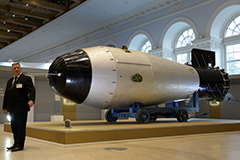Tsar Bomba
The Soviet RDS-202 hydrogen bomb, known by Western nations as Tsar Bomba was the most powerful nuclear weapon ever created. Tested on 30 October 1961 as an experimental verification of calculation principles and multi-stage thermonuclear weapon designs, it also remains the most powerful explosive ever detonated.
The bomb was detonated at the Sukhoy Nos (Dry Nose) cape of Severny Island, Novaya Zemlya, 15 km (9.3 mi) from Mityushikha Bay, north of Matochkin Strait. The detonation was secret but was detected by US Intelligence agencies. The US apparently had an instrumented KC-135R aircraft (Operation SpeedLight) in the area of the test, close enough to have been scorched by the blast.
The bhangmeter results and other data suggested the bomb yielded about 58 megatons of TNT, and that was the accepted yield in the literature until the Soviet scientists revealed that their instruments indicated a yield of 50 Mt in 1991. As they had the instrumental data and access to the test site, their yield figure has been accepted as more correct. In theory, the bomb would have had a yield in excess of 100 Mt if it had included a uranium-238 tamper, but because only one bomb was built, that capability has never been demonstrated.
The remaining bomb casings are located at the Russian Atomic Weapon Museum in Sarov and the Museum of Nuclear Weapons, All-Russian Research Institute of Technical Physics, at Snezhinsk. More details
The bomb was detonated at the Sukhoy Nos (Dry Nose) cape of Severny Island, Novaya Zemlya, 15 km (9.3 mi) from Mityushikha Bay, north of Matochkin Strait. The detonation was secret but was detected by US Intelligence agencies. The US apparently had an instrumented KC-135R aircraft (Operation SpeedLight) in the area of the test, close enough to have been scorched by the blast.
The bhangmeter results and other data suggested the bomb yielded about 58 megatons of TNT, and that was the accepted yield in the literature until the Soviet scientists revealed that their instruments indicated a yield of 50 Mt in 1991. As they had the instrumental data and access to the test site, their yield figure has been accepted as more correct. In theory, the bomb would have had a yield in excess of 100 Mt if it had included a uranium-238 tamper, but because only one bomb was built, that capability has never been demonstrated.
The remaining bomb casings are located at the Russian Atomic Weapon Museum in Sarov and the Museum of Nuclear Weapons, All-Russian Research Institute of Technical Physics, at Snezhinsk. More details

